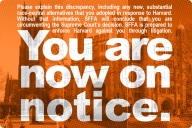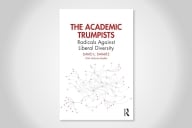You have /5 articles left.
Sign up for a free account or log in.
On the day Ann Finkbeiner planned to reach out to students accepted to Johns Hopkins University’s master’s degree program in science writing, she was met with a surprise: The decades-old program had been cut, and will not return in the fall.
The Hopkins science writing program was always an odd fit for the institution, Finkbeiner said -- not that it contradicted the research university’s mission, but because it was housed alongside a master of fine arts program in fiction and poetry in the writing seminars department. It also relied wholly on part-time employees and adjunct instructors.
“It fit, but it didn’t have a true home,” said Finkbeiner, who teaches in the program.
Katherine S. Newman, dean of the School of Arts & Sciences, alluded to that fit in her explanation for why the program was cut. The science writing program received between 20 and 30 applications and accepted between four and six students in an average year; this year, the number of applications was half the usual. In comparison, its fiction and poetry counterpart receives about 10 times as many applications while accepting only about 15 students.
The numbers weren’t up to the selective standards of the writing seminars department, Newman said. By fall 2014, the science writing program will be resurrected as a combined bachelor's and master’s degree program.
“This is a rebuilding process and an investment process as far as I’m concerned,” Newman said.
Although not all institutions that offer a degree in science journalism or writing report a decline in the number of applications, one trend appears to be developing: Programs that exist independently seem to be faring worse than those that can draw on the resources of a full-fledged journalism school.
At the University of California at Santa Cruz, the program director Robert Irion said applications for the science communication program have trended downward for the past three years. But since the program engages potential students before they even submit their applications, Irion said the decline has yet to affect the quality of the cohorts.
“We’re still able to recruit a full class of qualified students,” Irion said. “In general, I only need to give out usually 10 or 11 offers to get my 10 students.”
Among programs embedded in larger departments, the situation does not look as dire. New York University met its quota of 15 students for its science, health and environmental reporting program -- one of 10 concentrations graduate students can choose from.
The institution does not disclose how many applications it receives, but the director Dan Fagin said “what I’ve found is that the number sort of gyrates from year to year, and I’m waiting on a clear trend to emerge, and it hasn’t.”
Similarly, Boston University’s College of Communication reported an average year for its master’s degree program in science journalism, accepting nine students.
“It’s certainly not our top year for applications, but we got a terrific class,” said Ellen R. Shell, the co-director.
Unlike the stand-alone Hopkins program, the College of Communication has 2,269 students and 165 faculty members, two of whom are dedicated full-time to the science journalism program.
The program directors disagreed on the impact the perceived state of the journalism industry is having on fledgling science writers, who may stick to the sciences in what they perceive as a safer career move. Some, like Irion, said today’s job market offers more opportunities for his graduates -- despite the decline of print journalism.
“They are not even getting to the step of inquiring about this possible track, so we’re not even hearing from [potential students],” Irion said, who listed careers in online publications, private laboratories and government agencies as viable career paths. In reality, he said, “our employment rate among our graduates has never been better.”
But by replacing a master’s degree program with one aimed at undergraduates, program directors argue Johns Hopkins could be doing their students a disservice.
“I think that it would be really difficult for folks with an undergraduate science writing major to get a job in science journalism, because there are other students who have the extra credentials and the extra training -- more intensive training -- that you get at the graduate level,” Fagin said.
Newman pointed to Hopkins’s flexible core requirements, which make it easier for students to double major, as a reason why students enrolled in the new program should not be concerned about finding a job after graduation.
“The reason I’m not concerned is that we have so many unbelievable undergraduate students,” Newman said.“This is not in any way the end of science writing at Johns Hopkins University. This is a rebuilding process, and we believe our undergraduate students will have a lot to contribute.”








